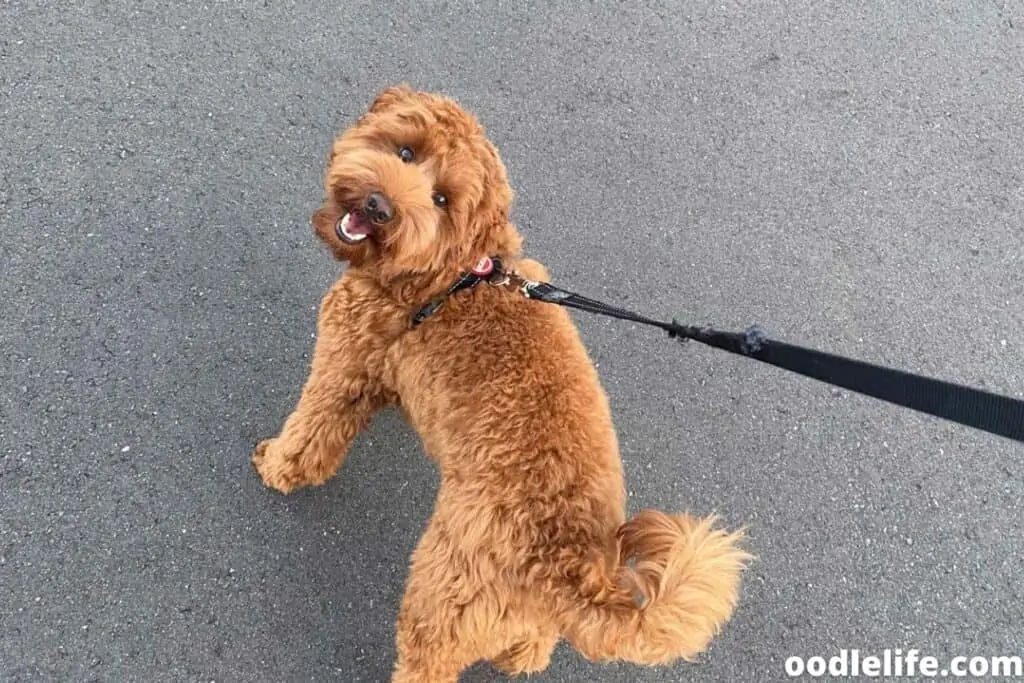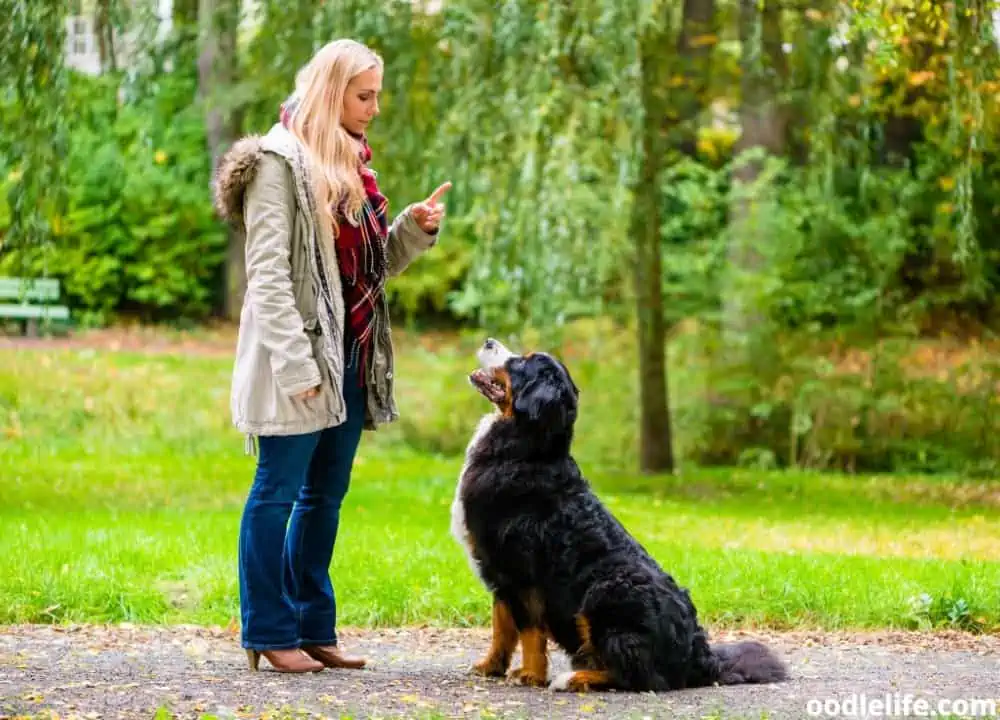How To Train Your Dog To Ignore Other Dogs?
To a dog owner, it is a tale as old as time. You’re walking your dog outside when you see another dog heading your way in the distance. Guess what?
Your dog saw it way before you did, and now you can see that your normally placid, peaceful dog is starting to stiffen up and react.

You dread getting nearer, but what do you do? Your dog is starting to lunge at the leash and pull, not listening to a word you’re saying. As you draw even nearer, your stress increases and your dog reacts even more by lunging powerfully or barking.
Finally, you give up and simply cross the road or reverse direction and run for the hills, dragging your dog with you.
You aren’t alone. Many dog owners are at their wit’s end as to why their normally peaceful dogs that walk politely on a loose leash turn into lunging demons when there are other dogs around. In fact, most dogs that don’t react to other intense stimuli like fireworks and gunshots will react when it comes to other dogs.
In this blog post, we’ll look at the many reasons your dog poorly behaves around other dogs and what you can do about it.
Why Does My Dog Pull Towards Another Dog?
There are many reasons why your dog is pulling with all its might towards another dog, and while not all of them are bad, they can be annoying behaviors especially if your dog is a large one that is likely to yank you off your feet. Here are some of the reasons why your dog is reacting to another dog:
1. Stressed
If you’ve ever owned a dog, you know that they’re sensitive creatures who can pick up on your moods and respond accordingly. But did you know that dogs can also get stressed out? When dogs are under stress, their heart rate and blood pressure increase, and they produce more of the stress hormone cortisol.

As a result, they become more reactive and may startle more easily. They may also pant excessively or become withdrawn and clingy. If your dog is exhibiting these behaviors, it’s important to try to reduce its stress level.
Lack of socialization can also lead to boredom, which can further exacerbate feelings of stress. Additionally, dogs can pick up on our own stress levels, so if we’re feeling anxious, they’re likely to mirror that emotion. If you are stressed because you know your dog is going to pull towards another dog, your dog will pick up on that and do exactly that.
2. Overly Playful Or Excited
Dogs can get excited for various reasons. Maybe your dog wants to meet the other dog very badly or wants to play. When dogs are excessively aroused, chemicals like adrenalin are released into their bloodstream, and they can go from excited to aggressive in a second.

Some dogs become very excited when they see another dog and will lunge toward them, making it difficult for their owner to control them. While this may seem like harmless fun, it can actually be dangerous for both dogs involved.
Dogs can get tangled up in their leashes, which can lead to falls and injuries. In addition, if one dog is not properly socialized, it may become aggressive when approached by another dog.
3. Fear Or Trauma
If your dog is inadequately socialized or suffers from previous trauma, he or she might be terrified of other dogs. When on a walk, the best defense might be an offense, and your fearful dog is warning other dogs away from him by lunging, growling, and barking on a leash.

When your dog is fearful of other dogs, it can be difficult to know how to help them. You’ll have to go back to the basics and start socializing them slowly and gradually, working up to having them meet another dog.
4. Too Much Energy
A hyperactive dog can be a reactive one. Dogs are known for their boundless energy, but sometimes that energy can get out of hand. If a dog doesn’t have an outlet for their physical and mental energy, they can become overly excited, anxious, or even aggressive with other dogs.

That’s why it’s so important to make sure your dog gets plenty of exercise. A good walk or run will help to burn off excess energy and keep your dog happy and healthy. In addition, interactive toys and games can help to keep your dog’s mind active and engaged.
How To Help A Reactive Dog?
Reactive dogs are seldom happy dogs. They constantly are in a state of heightened arousal and are not calm, relaxed, and happy. They are also difficult to train, and you might be making a few things worse by getting stressed yourself.
When you see another dog coming, you might hold on to the leash tighter, which will cause your dog to pull ahead. You might also give off lots of stressed body language or worse, fear that your dog will react. Now your dog can sense your fear and think that there is some danger coming.
Training your dog to ignore other dogs isn’t the easiest thing in the world but it can be done with loads of patience and consistency. Here’s how!
1. Get Your Dog’s Attention
If you’re looking for a way to get your dog’s attention, “watch me” is a cue that can be extremely useful. To teach your dog to “watch me,” start by getting their attention with a treat or toy. Once they are looking at you, say “watch me” in a clear, calm voice and hold up your hand in front of your face.

If they keep looking at you, give them a treat. If they look away, try again until they understand that they should keep their eyes on you when you say “watch me.” With practice, your dog will learn to focus on you even when there are distractions around. Now you have a way to get your dog’s attention when you’re on a walk.
2. Train At Home First
Before taking them out to somewhere with tons of distractions, make sure your dog can walk nicely on a loose leash. Fortunately, this is a relatively easy task that just takes a little patience and practice. The key is to start with short walks in low-traffic areas, and then gradually increase the length and difficulty of the walks as your dog becomes more comfortable.

It’s also important to be consistent with your commands. For example, if you always use the word “heel” when you want your dog to walk by your side, he will quickly learn to associate that word with the desired behavior.
3. Train Outdoors Without Other Dogs
Now that your dog is walking nicely on a loose leash, you can gradually increase the number of distractions and stimuli around him, but still, keep away from dogs. Bring loads of high-value treats like sausage chunks or anything your dog absolutely adores to keep his attention on you every time you say “heel” or “watch me.”

The goal here is that when you say one of the cue words, your dog is expecting a treat and directing his attention your way.
4. Introduce Another Dog
If you can, have someone with a calm dog help you out with this one. You can introduce the two dogs slowly without crossing paths. Walk your dog in the vicinity of another dog but not near enough that your dog reacts.

If your dog starts to react, increase the distance and offer a high-value treat if your dog’s attention stays on you.
Be patient, and slowly close the distance between both dogs, always moving away and asking for your dog’s attention when he starts to react or pull forward. Treat generously when your dog turns his attention to you instead of the other dog.
Soon, you might be able to have your dog alongside another dog, completely ignoring the other dog and keeping his attention on you and expecting a treat.
When Can Your Dog Socialize?
If you have managed to get your dog to completely ignore another dog on a walk and keep his attention on you, good job! Socialization is important but is only possible when your dog has learned to not react excitedly upon meeting another dog.

Once your dog can accomplish that, then you can let your dog know when it is okay to socialize and go say hi to calm, good-natured dogs that you meet on walks.
Instead of giving him the cue word and asking for attention, simply stop walking and give a release command like “okay,” which means it is okay for your dog to go and say hi and sniff butts or whatever they want to do.
Once the butt-sniffing is over, call for your dog’s attention again with the “watch me” or “heel” command and lead your dog away, giving a treat when he does what he’s told.
Final Thoughts
Reactive dogs are difficult to deal with at times, but with some patience and a whole lot of consistency, you can have a calm, well-behaved dog, even around other boisterous dogs.